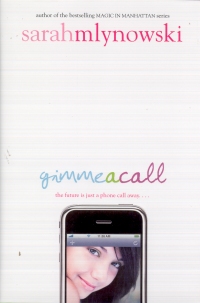| ________________
CM . . . . Volume XVII Number 10. . . .November 5, 2010. 
 |
Gimme a Call.
Sarah Mlynowski.
New York, NY: Delacorte Press (Distributed in Canada by Random House of Canada Ltd.), 2010.
301 pp., hardcover, $20.99.
ISBN 978-0-385-73588-9.
Subject Headings:
Dating (Social customs)-Fiction.
Conduct of life-Fiction.
High schools-Fiction.
Telephone-Fiction.
Grades 7-12 / Ages 12-17.
Review by Beth Wilcox.
**/4
|
| |
|

excerpt:
The phone vibrates again. I scrape my hand on a pencil but finally find it. Maya? I glance at the caller ID.
It says my number. My number is calling me again. What is going on? “Hello?”
“It’s you,” the girl from before says. “Good. I must have misunderstood you earlier. When you said ‘This is Devorah Banks,’ you meant me, right? As in I’m Devorah Banks? You recognized my voice?”
What is she talking about? “This is Devorah,” I say slowly. “Me. I’m Devorah. Who are you?”
“This is Devorah Banks!” she screams. “I am Devorah Banks! Just tell me who this is!”
Hotness erupts at the base of my neck and spreads to my cheeks like a bad rash. “I’m Devorah. Banks.”
“You can’t be,” she says. “That’s impossible! I’m hanging up!” The phone goes dead. A second later, it vibrates. Again, my number.
“Still me,” I sing.
“You’re crazy!” she screams.
“Alrighty then.” I press end, turn off the power, and toss the phone back into my bag. What, am I going to stay on the phone with some nut job who calls me names? I don’t think so.
Seventeen-year-old Devorah (Devi) Banks is heartbroken when Bryan, her boyfriend of four years, breaks up with her at the end of her senior year. Hurt and angry, Devi wishes she could change her past and erase their relationship. Devi’s wish comes true when her cell phone falls in the fountain of her local mall in Florence, New York. When she rescues the phone, she discovers it will only call and text one person: herself in grade nine.
Initially, the story is cute and light as Devi is able to talk to her younger self and explore all the answers to her various “what if” questions. As the narration of each chapter alternates between 14-year-old and 17-year-old Devi, the reader gets both the older regretful perspective and the pressure the younger Devi faces as she is given the burden to “fix” the problems looming in her future.
At the onset of the story, older Devi is likable and relatable in her heartbreak, but, as the novel progresses and she demands more of younger Devi, she quickly loses these characteristics and seems selfish in her attitude towards her younger self. Devi’s inability to accept relatively small negative consequences when altering major problems becomes irritating, such as her overreaction when preventing her best friend’s life-threatening anorexia results in the girl getting plastic surgery on her nose instead, or when her acceptance to Harvard University means she needs to get a loan or her parents will sell their house.
While the premise is obviously unrealistic, in the beginning the story is believable and highly entertaining. However, it begins to drag as Mlynowski repeatedly introduces far-fetched negative secondary results to many of Devi’s smaller changes in order to emphasize the message of living without regret. How Devi’s changes produce extreme unintended consequences is often left unexplained, such as when Devi tries to pay for college by winning the lottery and inadvertently causes her parents’ divorce, or when the decision to end the communication between Devi’s two selves somehow leads to her parents having another daughter.
Mlynowski clearly presents the message that all experiences shape one’s future self, and that life should not be lived in regret. Paradoxically, it is only by changing the past and her relationship with Bryan that Devi gains balance in her life, maintaining other friendships and putting effort into her schoolwork. Furthermore, as the reality of older Devi is constantly being altered based on the changes she orders younger Devi to undergo, somehow (in defiance of the message of accepting the past that had been overemphasized by previous mishaps) once the girls decide to stop communicating and older Devi gets “ready to face [her] future,” she finds her reality changed for the final time. Unlike other changes and without knowing what her younger self did, Devi’s new reality is better than any before. Her unemployed father and overworked mother are happy and have opened a small business, and she has a new little sister who was never present in any previous realities. The loose ends regarding Devi and Bryan’s relationship are cleanly tied in the final chapter, set three years later, when younger Devi discusses her amicable split from Bryan and drops her phone in the mall fountain. This time, when she tries to dial, she calls herself at age twenty-one. Having learned to accept their choices, both older and younger Devi wisely decide to end the call.
While there are plenty of gaps in the plot, many adolescent girls will enjoy this light story of wish fulfillment and the magical exploration of love and heartbreak.
Recommended with reservations.
Beth Wilcox is a Master of Arts in Children’s Literature candidate at the University of British Columbia.

To comment on this title or this review, send mail to
cm@umanitoba.ca.
Copyright © the Manitoba Library Association. Reproduction for personal use is permitted only if this copyright notice is maintained. Any other reproduction is prohibited without permission.
NEXT REVIEW |
TABLE OF CONTENTS FOR THIS ISSUE- November 5, 2010.
AUTHORS |
TITLES |
MEDIA REVIEWS |
PROFILES |
BACK ISSUES |
SEARCH |
CMARCHIVE |
HOME |
